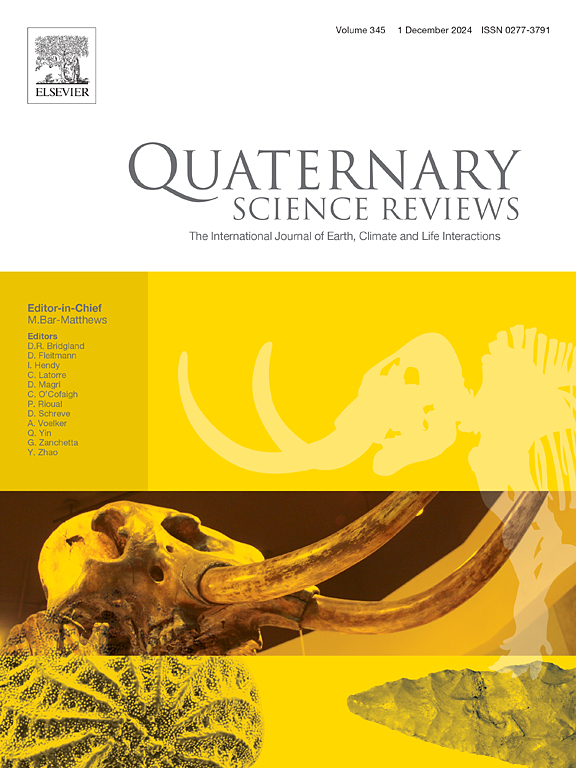从全新世演化的角度看当前暖期印度季风降水异常减少
IF 3.2
1区 地球科学
Q1 GEOGRAPHY, PHYSICAL
引用次数: 0
摘要
自工业化后全球变暖开始以来,关于印度季风的演变是否偏离了“降雨和热量同步”的自然基线,仍然存在重大争议。这个问题需要深入了解温度和季风降雨变化之间的长期相关性。我们选择位于青藏高原东南边缘的气候敏感亚高山湖泊云龙湖来研究这一问题。我们利用在硅藻季节调查中发现的喜暖浮游硅藻(Achnanthidium catenatum)和Aulacoseira granulata vara . angustissima)的相对丰度,半定量地揭示了暖季温度变化。同时,利用现代模拟技术(MAT)和加权平均偏最小二乘回归(WAPLS)方法构建了两个硅藻-水体深度传递函数,考察了表层硅藻群落在水深梯度上的空间分布规律,并对湖泊水位变化进行了定量重建。通过与独立的现代监测记录的比较,表明温水硅藻指标和两个硅藻传递函数对重建印度季风区长期温度和降雨变化具有敏感性和可靠性。在此基础上,依托湖泊深层完整的全新世沉积记录,重建了全新世暖季温度变化和湖泊水位波动。我们的重建结果表明,在全新世的几千年尺度上,印度季风区的温度和降雨呈现同步的“三阶段”逐步变化。这些阶段大致以8.2 ka和4.2 ka的气候事件为标志,暖季温度和湖泊水位的最大值出现在全新世中期。研究发现,该地区全新世中期的最大降水和最大热量与暖季(夏秋)日照高峰大致重合。这可能与当时陆地和海洋的显著温差有关,表明在长时间尺度上,印度季风域的降雨和温度是同步变化的。本文章由计算机程序翻译,如有差异,请以英文原文为准。
Abnormal reduction in Indian Monsoon rainfall during current warm period from the Holocene evolution perspective
Since the onset of post-industrial global warming, there remains significant controversy over whether the evolution of the Indian Monsoon has deviated from the natural baseline of ‘rainfall and heat synchronization’. This question requires a deep understanding of the long-term correlation between temperature and monsoon rainfall changes. We selected Yunlong Lake, a climate-sensitive subalpine lake located on the southeastern margin of the Tibetan Plateau, to study this issue. We semi-quantitatively revealed warm-season temperature changes using the relative abundance of warm-preference planktic diatoms, namely Achnanthidium catenatum and Aulacoseira granulata var. angustissima, found in our diatom seasonal survey. Meanwhile, by examining the spatial pattern of surface diatom assemblages along the water depth gradient, two diatom-water depth transfer functions were constructed by using the modern analogue technique (MAT) and weighted average partial least squares regression (WAPLS) method, which were used to quantitatively reconstruct past lake water level changes. Comparison with independent modern monitoring records, the warm-water diatom indicators and the two diatom transfer functions suggest to be sensitive and reliable for reconstructing long-term temperature and rainfall changes in the Indian Monsoon domain. Based on this, and relying on the complete Holocene sedimentary records from the profundal zone of the lake, we reconstructed the warm-season temperature changes and lake water level fluctuations during the Holocene. Our reconstruction indicates that the temperature and rainfall in the Indian Monsoon domain exhibit a synchronous, ‘three-stage’ stepwise change over the multi-millennial scale of the Holocene. These stages are roughly marked by the climate events of 8.2 ka and 4.2 ka, with the maximum warm-season temperature and lake water level occurring during the middle Holocene. We find that the maximum rainfall and heat during the middle Holocene in this region roughly coincide with the peak of warm-season (summer-autumn) insolation. This may be related to the significant thermal difference between land and ocean at that time, suggesting a synchronous change in rainfall and temperature in Indian Monsoon domain over long timescales.
求助全文
通过发布文献求助,成功后即可免费获取论文全文。
去求助
来源期刊

Quaternary Science Reviews
地学-地球科学综合
CiteScore
7.50
自引率
15.00%
发文量
388
审稿时长
3 months
期刊介绍:
Quaternary Science Reviews caters for all aspects of Quaternary science, and includes, for example, geology, geomorphology, geography, archaeology, soil science, palaeobotany, palaeontology, palaeoclimatology and the full range of applicable dating methods. The dividing line between what constitutes the review paper and one which contains new original data is not easy to establish, so QSR also publishes papers with new data especially if these perform a review function. All the Quaternary sciences are changing rapidly and subject to re-evaluation as the pace of discovery quickens; thus the diverse but comprehensive role of Quaternary Science Reviews keeps readers abreast of the wider issues relating to new developments in the field.
 求助内容:
求助内容: 应助结果提醒方式:
应助结果提醒方式:


